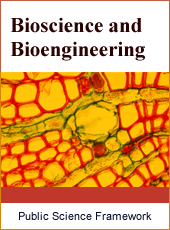Bioscience and Bioengineering
Articles Information
Bioscience and Bioengineering, Vol.1, No.2, Jun. 2015, Pub. Date: May 28, 2015
Technology Applications of the Low Drag Shapes of Aquatic Animals
Pages: 29-33 Views: 5880 Downloads: 1469
[01]
Igor Nesteruk, Institute of Hydromechanics, National Academy of Sciences of Ukraine, Kyiv, Ukraine.
The best swimmers have a streamlined shape that ensures an attached flow pattern even in the case of inertial motion (without varying the body shape). Similar rigid bodies of revolution were calculated and tested in the wind tunnel. In the middle of the body, the measured static pressure is significantly higher than the theoretical values. The influence of this fact on the boundary layer separation was estimated. In order to explain the discrepancy in experimental and theoretical pressure distributions, some inverse problems were solved.
Drag Reduction, Boundary Layer Separation, Flow Control, Aquatic Animals
[01]
Gray, J. 1936 Studies in animal locomotion VI. The propulsive powers of the dolphin. J. Exp.Biol. 13, 192-199.
[02]
Aleyev, Yu. G. Nekton. Dr. W. Junk, The Hague, 1977.
[03]
Rohr, J., Latz, M. I., Fallon, S., and Nauen, J. C. Experimental approaches towards interpreting dolphinstimulated bioluminescence. J. Exper. Biology 201: 1447–1460, 1998.
[04]
L.D. Landau, E.M. Lifshits, Fluid Mechanics, Second Edition: Volume 6 (Course of Theoretical Physics), Butterworth-Heinemann, 1987.
[05]
Zedan, M.F., Seif, A.A. & Al-Moufadi, S. Drag Reduction of Fuselages Through Shaping by the Inverse Method. J. of Aircraft 31, No. 2: 279-287. 1994
[06]
Lutz, Th. & Wagner, S. Drag Reduction and Shape Optimization of Airship Bodies. J. of Aircraft. 35, No. 3: 345-351, 1998.
[07]
Goldschmied, F.R. Integrated hull design, boundary layer control and propulsion of submerged bodies: Wind tunnel verification. In AIAA (82-1204), Proceedings of the AIAA/SAE/ASME 18th Joint Propulsion Conference, pp. 3–18, 1982.
[08]
Nesteruk, I. Experimental Investigation of Axisymmetric Bodies with Negative Pressure Gradients. Aeronautical J. 104: 439-443, 2000.
[09]
Nesteruk, I. New type of unseparated subsonic shape of axisymmetric body. Reports of the National Academy of Sciences of Ukraine, 11: 49-56, 2003 (in Ukrainian).
[10]
Nesteruk, I. Rigid Bodies without Boundary-Layer Separation. Int. J. of Fluid Mechanics Research, 41, No. 3: 260-281, 2014.
[11]
I. Nesteruk, G. Passoni, A. Redaelli. "Shape of Aquatic Animals and Their Swimming Efficiency," Journal of Marine Biology, vol. 2014, Article ID 470715, 9 pages, 2014. doi:10.1155/2014/470715.
[12]
Nesteruk, I. Peculiarities of Turbulization and Separation of Boundary-Layer on Slender Axisymmetric Subsonic Bodies. Naukovi visti, NTUU “Kyiv Polytechnic Institute” 3, 70-76. 2002. (in Ukrainian).
[13]
I. Nesteruk, Reserves of the hydrodynamical drag reduction for axisymmetric bodies, Bulletin of Univ. of Kiev, Ser.: Phys. & Math. 4 (2002) 112-118.
[14]
L.G. Loitsyanskiy. Mechanics of Liquids and Gases, Begell House, New York and Wallingford, 6th ed, 1995.
[15]
Kwang S. Hyun, Paul K. Chang. The criterion of separation of incompressible laminar boundary layer flow over an axially symmetric body. JJ. of the Franklin Institute, v. 325, Issue 4, 1988, pp. 419–433.

ISSN Print: 2381-7690
ISSN Online: 2381-7704
Current Issue:
Vol. 6, Issue 3, September Submit a Manuscript Join Editorial Board Join Reviewer Team
ISSN Online: 2381-7704
Current Issue:
Vol. 6, Issue 3, September Submit a Manuscript Join Editorial Board Join Reviewer Team
| About This Journal |
| All Issues |
| Open Access |
| Indexing |
| Payment Information |
| Author Guidelines |
| Review Process |
| Publication Ethics |
| Editorial Board |
| Peer Reviewers |


